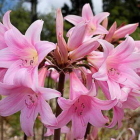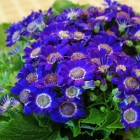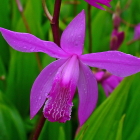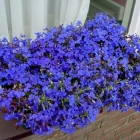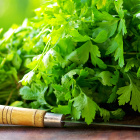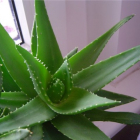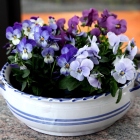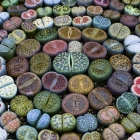Representatives of the genus Gasteria (Gasteria) are endemics of South Africa and grow in the coastal and semi-sore regions of Quadzul-Natal, Cabo and East Transvaal (South Africa). Gasterei are closely connected with Aloe and Havorti, with which they previously entered the Lilaceae family (Liliaceae), and now - in a separate  aloaceae family.
aloaceae family.
The genus combines perennial leafy grassy, \u200b\u200bmostly silly-resistant succulents with simple thick elongate-elliptic (lovers call them "linguifications") leaves that have a well-developed cuticle. In young copies, the location of the leaves is a two-round (contrary to another), with age - most gastere becomes spiral. The edges of the leaves are all-string, the tip is sharp. The surface of the sheet plate has a spotted pattern or characteristic light small tubercles.
Swimpberry flowers, end with a loose brush. Flowers are small, tubular, with controversial segments of the perianth. The tube is curved, in the upper part of the cylindrical, in the bottom - with bloating, which served as the basis for the name of the genus (from the Greek word Gaster - "belly, stomach"). As a rule, the top of the flower is light green, the base is painted in red, pink, yellowish shades. The fruit is a triangular box with flat seeds and falling out when swinging a blond tree.
Contents in culture
Gasteria can be attributed to unpretentious plants. In sunny window sills, they need easy shading from direct sunlight, otherwise the leaves are blushing and dried. When the northern exposition of gasterei on the windowsill is growing well, but the socket becomes more loose, flowering is weakened. The most-optimal temperature for cultivation is in summer + 20-30 degrees., In winter + 12-20 degrees. Some types of gastrelia in natural populations carry low temperatures (up to 1 deg.).
Gasteria is not demanding to the soil, it is quite suitable for anyone with the addition of coarse sand. In the growing season (from March to September), Gasteria is poured abundantly, as the soil is burned. In autumn and winter, watering is limited at temperatures below +10 degrees. - Fully stop.
Possible problems
Gasteria rarely damage pests and diseases. Coccuses can be found from pests: milders, shrews. It is not easy to fight with them, so quarantine measures should always be done. The following chemicals are applied against all coccid: Aktara, confident, a spark of gold, tanker and other drugs based on the active substance imidaclopride.
At low temperatures and high humidity, air can be covered by spots of various sizes and coloring. Such damage causes a mushroom infection. Sick plants should be treated with fungicides and provide them with dry content.
Over time, the lower leaves are prone to full drying, they can be removed during a transplant or transshipment of plants.
Reproduction
Gasterey spread the daughter sockets, leaf cuttings, seeds. Most of the species are abundantly overgrown with escapes, so it is easily multiplied vegetatively. The reproduction of leaf cuttings is practiced: the cut sheet is dried and rooted in a peat mixture with sand (perlite or vermiculite). Within 1 -2 months, kidneys are formed on the sheet cut, of which new shoots grow. Even a small incision on the gastere leaf plate can cause the formation of shoots.
Seeds are sometimes difficult to acquire, but it is precisely the cultivation of gastryia from seeds - the most interesting way, with which the beautiful instances can be selected from the crops. The process is not complicated at all. Seeds from gastreli black, flat, large (up to 5 mm), and not dusty, as sometimes they write amateurs about it. Substrate for sowing - any soil for plants, mixed with coarse-grained sand (1: 1). It is advisable to disappear in the water bath for about an hour or shed in advance with fungicides.
Before sowing, the soil is well moistened, the seeds are laid out on the surface of the substrate and sprinkled with a small layer of coarse sand. Before germination, seeds are covered with glass or polyethylene package, only occasionally spraying the frying top layer of the substrate. The optimal temperature for the extension is + 20-28 degrees. The first shoots may appear after 5-7 days after sowing, most are within a month.
During this period, it is necessary to put a wagon with all the ways either in greenhouse with gas-discharge lamps (daylight lamps), or on a light warm windowsill, transducted from direct sunlight. Sowing preferably to air daily. Gasteria belongs to monocoons, so one should not be surprised that seedlings have one cotyled and a bright case. The first picking should be carried out after 1-2 months, depending on the growth of seedlings growth.
Variety of Gasterei
The most common types of culture: Gasteria Bicolor Var. Liliputana, G. Carinata Var. Verrucosa (People's name - "Deer Language"). Collectors are very popular 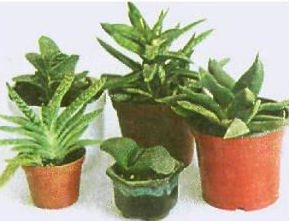
In recent years, interest in Gasterey increased noticeably, especially for little-known, but very spectacular species and cultivars (varieties). Very beautiful small in size G. Baylissiana, whose leaves are covered with small white tubercles. This gastry is desirable to provide good lighting. Decorative G. Pulchra. The leaves are located almost vertically, up to 20-30 cm long, shiny, dark green with beautiful creamy white stains that give this mind. Bright appearance. For lovers of large forms, G. Disticha, G. Excelsa, G. Bicolor Var can be recommended. Bicolor (reaches 40-60 cm).
Selection masterpieces Several breeders from Japan and the United States pay attention to the creation of cultivars Gasteria. Selection is aimed at obtaining plants with beautiful leaves. From numerous cultivars most often occurs in the collections, Little Warty is found. A special line of selection is the cultivars based on G. armsrongii. Some obtained hybrids have wide tight leaves with a silver tint. Another hybrid line G. Armsrongii is very rare volatile gastereys. At the base of G. Gracrlrs, cultivars were obtained with. Acellent varnish leaves: Pink, Misuzu No Fuji - with white-pink stripes; White, Misuzu Fuji - with silver-white stripes, etc.
Gastereys are particularly slow, in the leaves of which lower chlorophylls. For example, a very beautiful cult of Var Sakura Fuji in one growing season will grow up just a couple of centimeters.
Gasterey is easily hybridized with chavorts, aloe, as a result of which intermedidal hybrids became known - XGasterHaworthia, Xgasteraloe. The most beautiful interrobal hybrid between Gasterei and Aloe Variegata is Xgasteraloe Green Ice.
We hope that gastreli will become popular pearls in the collections of succulent lovers!
On a note:
Growing Vanda
Cash care
Sadik from succulents
How to care for azalia
How I raised grenade at home
Art bonsai.
Gasterei - Pearls of the Succulent Collections
Comments leave a comment
 Start a discussion ...
Start a discussion ...


